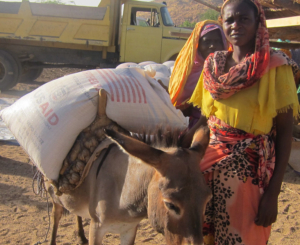USAID Programs in Chad
 Chad, “the fifth largest country in Africa,” is also “one of the world’s poorest countries.” Once a colony of the French Empire, Chad declared its independence in 1960, but troubles did not end there. Starting in 1966, Chad entered into a civil war that would prove to be one of Africa’s longest. Forward to the 21st century and political instability continues to manifest in rebel attacks and pre-election violence. Besides civil unrest, Chad has recently endured severe flooding in its Lac Province, where approximately 381,000 domestic refugees took shelter as of 2022. In 2024, an additional 54,000 people were displaced. Chad takes the most refugees per capita within the African continent, particularly those from Sudan due to ongoing conflict and economic factors further worsening Chad’s crises, according to the Norwegian Refugee Council (NRC).
Chad, “the fifth largest country in Africa,” is also “one of the world’s poorest countries.” Once a colony of the French Empire, Chad declared its independence in 1960, but troubles did not end there. Starting in 1966, Chad entered into a civil war that would prove to be one of Africa’s longest. Forward to the 21st century and political instability continues to manifest in rebel attacks and pre-election violence. Besides civil unrest, Chad has recently endured severe flooding in its Lac Province, where approximately 381,000 domestic refugees took shelter as of 2022. In 2024, an additional 54,000 people were displaced. Chad takes the most refugees per capita within the African continent, particularly those from Sudan due to ongoing conflict and economic factors further worsening Chad’s crises, according to the Norwegian Refugee Council (NRC).
The country’s primary export is oil, but other financial sectors have seen minimal development and coupled with high levels of debt, its economy struggles to cope with the crises it faces. Chad currently ranks 190th on the Human Development Index (HDI) out of the 191 countries listed, according to the German Federal Ministry for Economic Cooperation and Development (BMZ). As such, foreign aid is incremental to Chad’s development, and the rest of this article will demonstrate the role of the U.S. Agency for International Development, particularly USAID programs in Chad.
Reducing Poverty and Food Insecurity
According to the World Food Program (WFP), approximately 2.1 million people in Chad are acutely food insecure as of 2023, while 1.36 million of its children struggle with malnourishment and 42% of its population lives below the poverty line. The USAID recognizes this in its foreign aid commitments, seeking to address the immediate need for humanitarian aid. USAID’s 2022 Chad Assistance Overview highlights contributions of $54.9 million in funds for food assistance. This includes food vouchers, cash transfers for food, nutrition assistance and malnutrition treatments.
As of January 2024, Chad hosted more than 1.1 million refugees, of which 934,000 came from Sudan. USAID has supported the Chad Rapid Response Mechanism, supplying nearly 7,800 internally displaced people with hygiene and kitchen supplies and constructing nearly 70 emergency shelters for refugees, according to its 2024 Chad Assistance Overview. These commitments are but a symptom of USAID’s continued efforts to increase food and national security.
Success Stories in the Villages
Since 2008, USAID has partnered with Africare to provide villages with better-quality water and alleviate some of their hygiene and food security crises. Abdelmadjid Ali, member of Mourdaba’s water management committee and father of five notes that before USAID programs in Chad, there was no organization within the community to deal with water management, and as a result “villagers consumed dirty and unclean water and this exposed them to all kinds of diseases including diarrhea and cholera.” Since then, USAID helped construct 113 water wells, which now benefit nearly 35,000 people.
Another success story comes from USAID’s cultural efforts. Seeking to address the political instability that is the cause of so many of Chad’s other crises, USAID funds the Peace Through Development II program. The program supports radio shows that broadcast sensitive and educational topics through sketches and mini-dramas. In this way, USAID hopes to counter the extremism that has plagued Chad and contributed to its citizens’ poor living conditions. Besides this, the program provides community and creative expression to Chad’s impoverished populations.
Ending Note
The total emergency funding provided by USAID programs in Chad in the fiscal years 2022 to 2024 stands at $166,360,752, according to the 2024 Assistance Overview. This sum has contributed to some great success stories, including increased food security, refugee relief and aid and cleaner water sources. Chad, however, remains the 9th poorest country in the world, according to Global Finance, and its stretched resources, the ongoing refugee crisis and periodic flood devastation further worsen this situation. While USAID programs in Chad have made some good strides toward improving living conditions within the country, increased foreign aid continues to be an absolute necessity to address the continuing humanitarian crisis.
– Kayleigh O’Brien
Photo: Flickr
